The journey among the animals and fantastic creatures of Italian museums reaches its fourth leg with Piedmont: here are the creatures we found at the foot of the Alps, in these museums teeming with life, to visit safely, to spend time alone, with family or with friends. The Animals and Fantastic Places project is a collaboration between Finestre Sull’Arte and the Ministry of Culture.
The sphinx is a mythological animal that has the body of a lion and the head of a man, symbols of strength and intelligence, respectively.The Egyptian Museum in Turin preserves, among others, two large sandstone sphinxes, each approximately three meters long, from the temple of Amun in Thebes and dating back to the 19th dynasty (1292-1250 B.C.). They are depicted in the typical lying pose, with the front legs stretched forward, and the tail resting along the body, while the human face appears with other typical features such as the headdress and long beard. Pairs of similar sphinxes were usually placed opposite each other at the entrance to a temple (or inside temple rooms): they were in fact the guardians of the places in front of which they were placed. Both statues are part of the nucleus from which the Egyptian Museum originated, that of the explorer and collector Bernardino Drovetti, whose collection was purchased in 1824 by King Charles Felix, who thus opened the world’s first Egyptian Museum.

For the ancient Greeks, “time” had multiple meanings. There was Krónos, time understood in its duration. And there was Kairós, time understood as occasion, as opportune moment. There was also a deity, Kairós precisely, in charge of propitious moments (it was not strange that in Greek mythology there were personifications of abstract ideas or concepts, such as victory, wealth, and so on). The relief in the Museum of Antiquities in Turin depicts the god Kairós according to the iconography invented by the great Greek sculptor Lysippus: the “opportune moment” is depicted as a winged genius, equipped with shoes that are also winged (the wings are a symbol of the fleetingness of the propitious moment that can leave at any moment), while he holds a scale and a razor. In this case, the scales are balanced on the razor, symbolizing that the good moment is thinner and sharper than the blade of a razor. The scales, on the other hand, symbolizes the decision between two destinies, separated by whether or not the moment is seized. Finally, it will be noted that the nape of the genie’s neck is shaved: this is because once the good moment has escaped, it can no longer be grabbed from behind ... by grabbing it by the hair. The relief in Turin’s Museum of Antiquities, made of Pentelic marble, is a Roman copy of a Greek original.
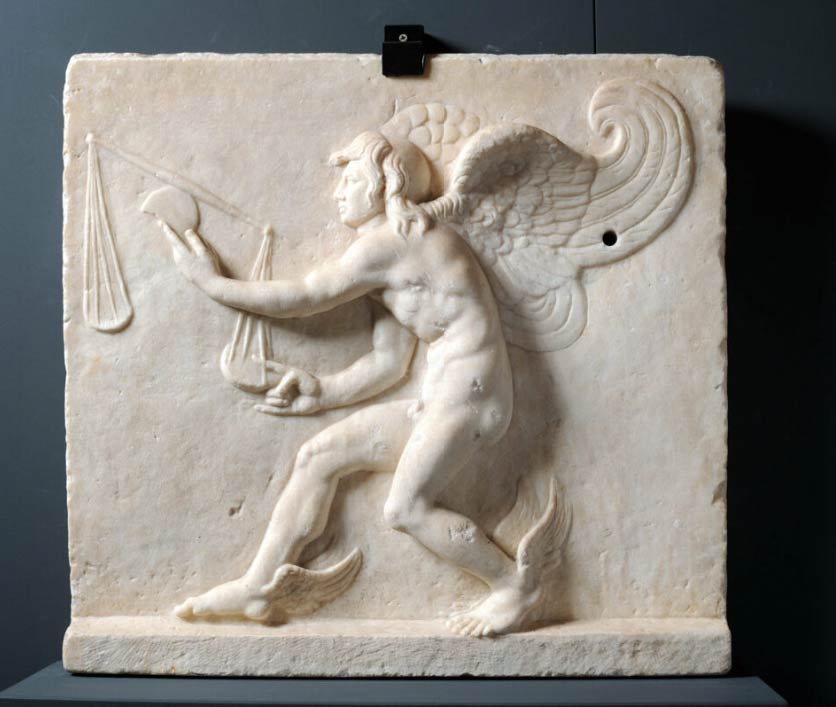 Roman copy from a
Roman copy from aDaphnis, not to be confused with Daphne, the nymph loved by Apollo and turned into a laurel tree to escape the god’s attentions, was a Sicilian shepherd boy, son of the god Eros and the nymph Daphnis. He is credited with the invention of bucolic poetry, but it is interesting to know that he is often depicted together with the god Pan. The latter, as can be clearly seen in the group in the Museum of Antiquities in Turin, was a deity who had the body of a man and the legs of a goat: particularly revered in Arcadia, he was the god of forests and pastures and thus protected shepherds and hunters. According to myth, Pan is said to have taught Daphnis how to play the flute: in fact, the goat-like god was believed to be the inventor of the syrinx (also known as “Pan’s flute”), the wind instrument with a series of joined reeds. Moreover, Daphnis would also have been his lover: indeed, we see Pan posing affectionately, encircling the young man’s body with his arm. The group in the Museum of Antiquities, made of white marble, dates from between the second half of the 1st century AD and the first half of the 2nd century AD.
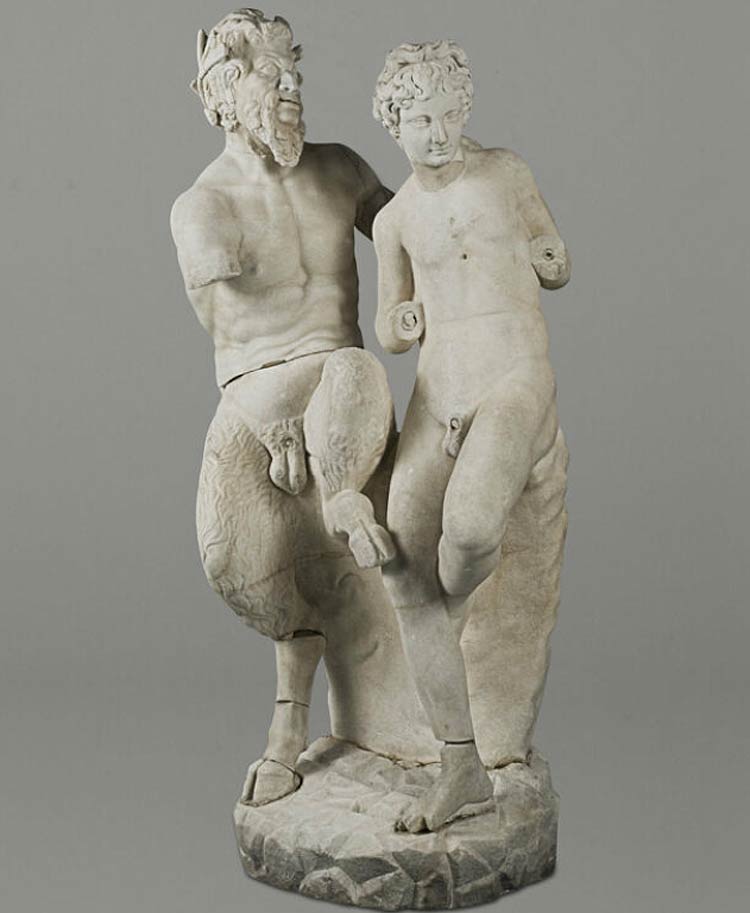
The oil lamp was a widespread object in ancient Rome: it was used for lighting and, indeed, was the most widely used of the instruments used for that purpose. It was usually made of terracotta or bronze. A central body, usually round in shape but the shapes could be the most varied, was filled with oil, which was made to burn through a wick, typically made of linen or hemp, inserted from the spout. The central disc was decorated with the most varied figures-imagine, for example, today’s lighters, on which the imagination of decorators ventures. It worked the same way with oil lamps: craftsmen in the Roman world depicted all kinds of scenes and characters, and so oil lamps with fantastic creatures were also widespread. Like this one from the Museum of Antiquities in Turin, where we see the figure of Pegasus, the mythical flying winged horse, here depicted upright on his hind legs. According to myth, Pegasus was the horse with which Zeus carried his thunderbolts. Later tamed by the hero Bellerophon, it was used by him to kill the chimera, and following the hero’s death, unhorsed by Pegasus through the intervention of the gods envious of him and having become an invalid, the winged horse returned among the deities.
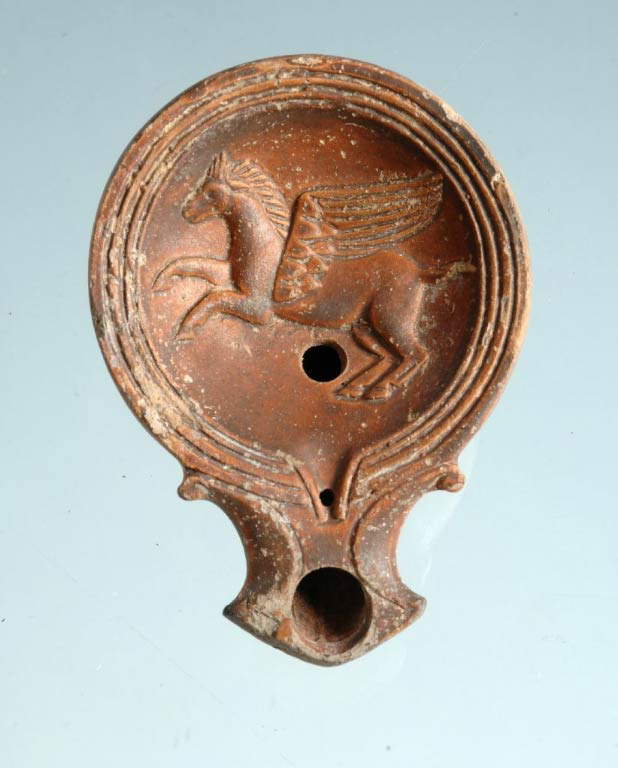
This elegant casket is in the collections of the Royal Palace in Turin, and in particular can be seen in the Sala del Caffè on the second floor. It was made between 1740 and 1750 by Pietro Piffetti, an expert cabinetmaker from Turin who, under Charles III of Savoy, was also appointed court cabinetmaker: he had no equal in the entire Duchy of Savoy. The collections of the Royal Museums preserve many of his works, but this one stands out for its high virtuosity: it is an object made of walnut, rosewood, and boxwood (woods known for their hardness and used in the past for luxury objects that were meant to last), with ivory inlays and gilded bronze decoration. The decoration is rich in fanciful motifs inspired by ancient mythology: thus centaurs, sirens, tritons, and monstrous fish appear to take us to a sea world populated by fantastic creatures.
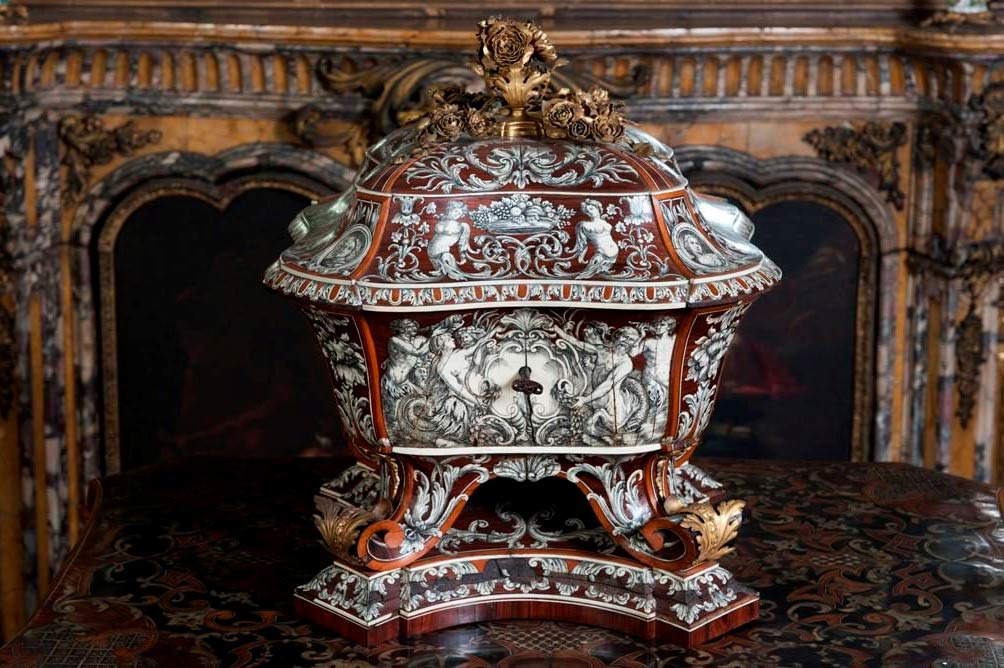
“Pump wheel” is understood to mean a particular circular and slightly convex shield, ceremonial (i.e., it was used in parades and official occasions): this one, preserved in the Royal Armory in Turin, is particularly luxurious and elaborate and features in the center one of Hercules’ labors, the slaying of the Hydra of Lerna. The Hydra was a legendary, snake-bodied monster with nine heads, with the central one immortal, and the others capable of regrowing if cut off. It was also a very venomous animal, able to kill with breath alone, and extremely intelligent. Hercules killed the Hydra during the second effort, thanks to the help of his friend Iolaus, who cauterized the severed heads, preventing them from regrowing, while Hercules crushed the central head to permanently subdue the monster. In the caster in the Royal Armory in Turin, Hercules is about to strike the monster with his club, and it responds by trying to wound him with its claws. The depiction is very detailed because we also see Iolaus, on the left, holding the flashlight used to burn the monster’s wounds. Finally, on the right, we again see Hercules dipping his arrows in its blood after killing the Hydra to create deadly poisoned weapons. We do not know who the author of this pump wheel is, but the manner recalls some Milanese masters such as Leone Leoni and Hannibal Fontana.
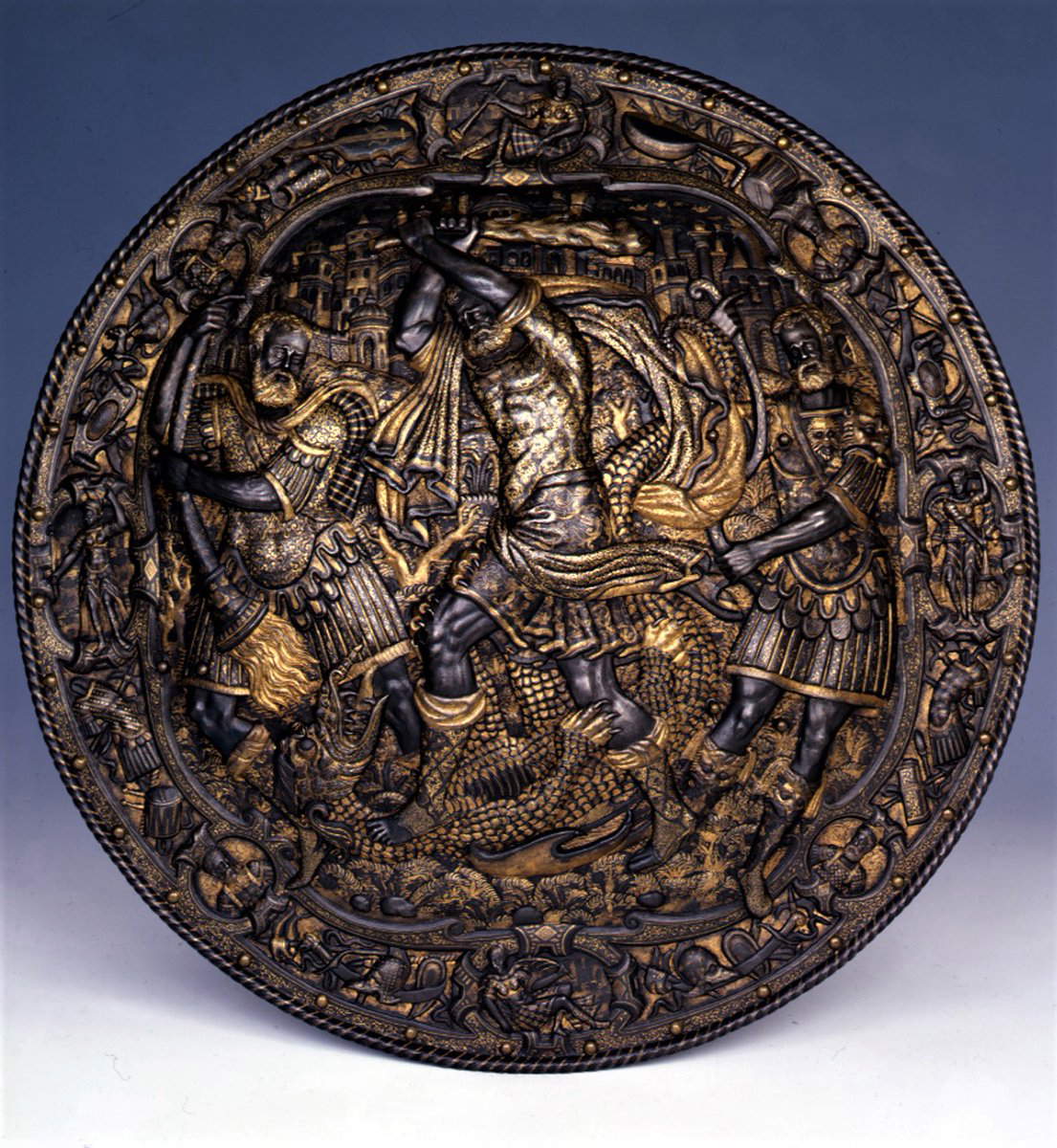
Mythology narrates that Andromeda, a sea nymph, was punished because her mother, Cassiopeia, kept boasting about her daughter’s beauty, as she claimed she was the most beautiful of the Nereids (the sea nymphs). Poseidon then sent against King Cepheus, Cassiopeia’s husband and Andromeda’s father, a terrible sea monster that brought destruction to the shores of his kingdom. The oracle Ammon vaticulated that the only way to get rid of the monster was to sacrifice the beautiful Andromeda: thus, the young girl was chained to a rock, offered as a sacrifice to the dreadful creature. She was saved, however, by Perseus, who happened by the cliff where Andromeda was chained, killed the monster and freed the young girl. In the painting by Bartolomeo Passerotti (Bologna, 1529 - Rome, 1592), Andromeda is depicted nude, as is often the case in paintings that deal with this subject and are therefore cloaked in a vein of eroticism, while Perseus, with his sword, is preparing to cut the chains. There are as many as three fantastic creatures in this painting: not only the monster, which takes the form of a bizarre, sharp-toothed fish, but also Medusa, defeated by Perseus shortly before Andromeda’s liberation (we see her head on the left), and Pegasus, who, according to legend, was born from Medusa’s own blood. Interestingly, above the monster the author has minutely depicted plants and shells, a sign of the great interest in the sciences that, in Passerotti’s learned Bologna, had spread thanks to the work of the scientist and naturalist Ulisse Aldrovandi, who created one of the world’s first natural history museums.

Margaret of Antioch was a young Christian woman who, for refusing the attentions of the prefect Ollarios, was denounced and then imprisoned: during her imprisonment she was visited by the devil who appeared to her in the guise of a large dragon. According to legend, Margaret, armed only with her faith and a crucifix, defeated the devil by the power of her prayers alone. The way in which the author of this painting (attributed to Nicolas Poussin) depicts the dragon is truly singular: the head looks almost like that of a dog, the body that of a crocodile, and around it we see a snake clinging, which in turn turns toward the saint. Most striking is the contrast between the appearance of the hideous monster and the calmness of the saint who, calm and heedless of the demon (indeed: she ignores him altogether), turns toward the angels who arrive to crown her.

In Turin’s Villa della Regina, visit the private sitting room of the Queen’s Apartment, decorated by Pietro Massa (news from 1721 to 1760) around 1733. Massa, a painter about whom we know little, specialized in producing works inspired by Oriental art, whose artistic techniques he also imitated. He had never been to China or Japan, but he knew how to paint oriental characters, animals, landscapes and buildings simply by observing what came from China to Turin: vases, porcelain statues, fabrics, painted papers, lacquered wooden objects. Here, then, in the queen’s private drawing room he painted in a very fresh and lively way various scenes of daily life in the Orient, at a time when “chinoiserie” was a particularly fashionable genre. And among the decorations in the drawing room of the Queen’s Villa is a group of men holding up a winged animal with some poles: Massa depicts here the “Dance of the Dragon,” a traditional dance performed at Chinese New Year celebrations, which is still danced today in China and in Chinese communities around the world that engage in complex choreography, with the dragon still being moved with the same poles. While in Europe anciently the dragon was associated with the forces of evil, by contrast in the East it was the bearer of good fortune and a symbol of strength, dignity, and wisdom. Moreover, unlike European dragons, which almost always take the form of huge reptiles, often winged, Chinese dragons can combine together the forms of various animals: deer, bulls, rabbits, tigers, fish and more, with anatomical elements of these animals being grafted onto a snake body.
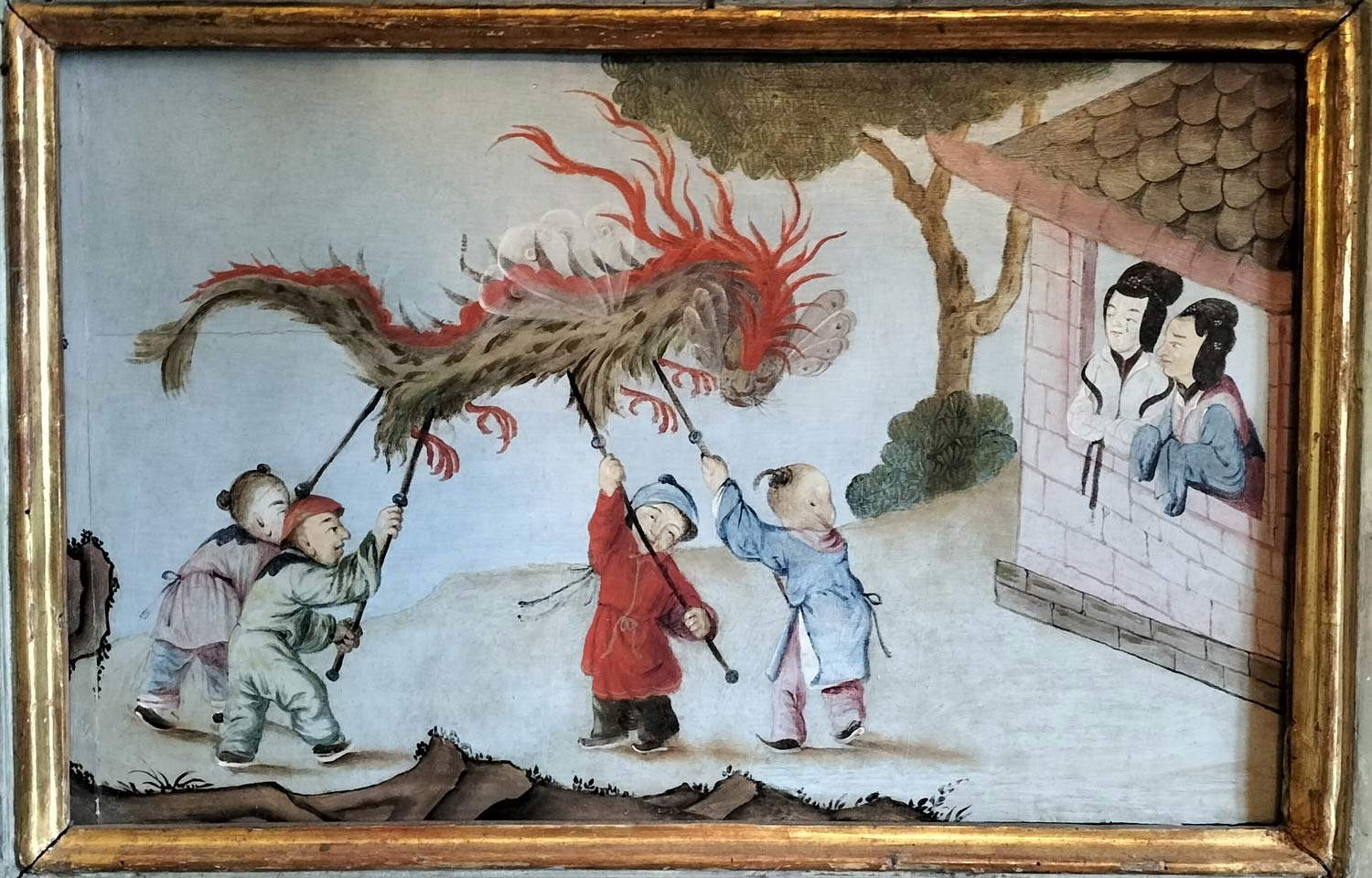
In this floor mosaic from the second half of the 11th century, found in the Abbey of Fruttuaria in San Benigno Canavese, we can see two rampant griffins facing each other: they are made of white, black and blue tiles and are enclosed in a braided frame, the central rounds of which are made of terracotta. Between them we observe instead the depiction of the tree of life. The griffin, according to mythology, was a fantastic bird that had the body of a lion, legs, wings and the head of an eagle. In the Christian imagination, the griffon is a positive animal: it is associated with Christ (the lion, an earthly animal, and the eagle, a flying animal, represent the dual divine and human nature of Jesus), but also with the evangelists John and Mark, since the animals whose characteristics it has are their symbols (St. John’s eagle and St. Mark’s lion). In Benedictine monasteries, such as the Abbey of Fruttuaria, the griffon, a hybrid being, and one that therefore retains part of its bestial nature, by feeding on the fruit of the tree of life loses this nature, turns away from sin, and thus joins Christ.
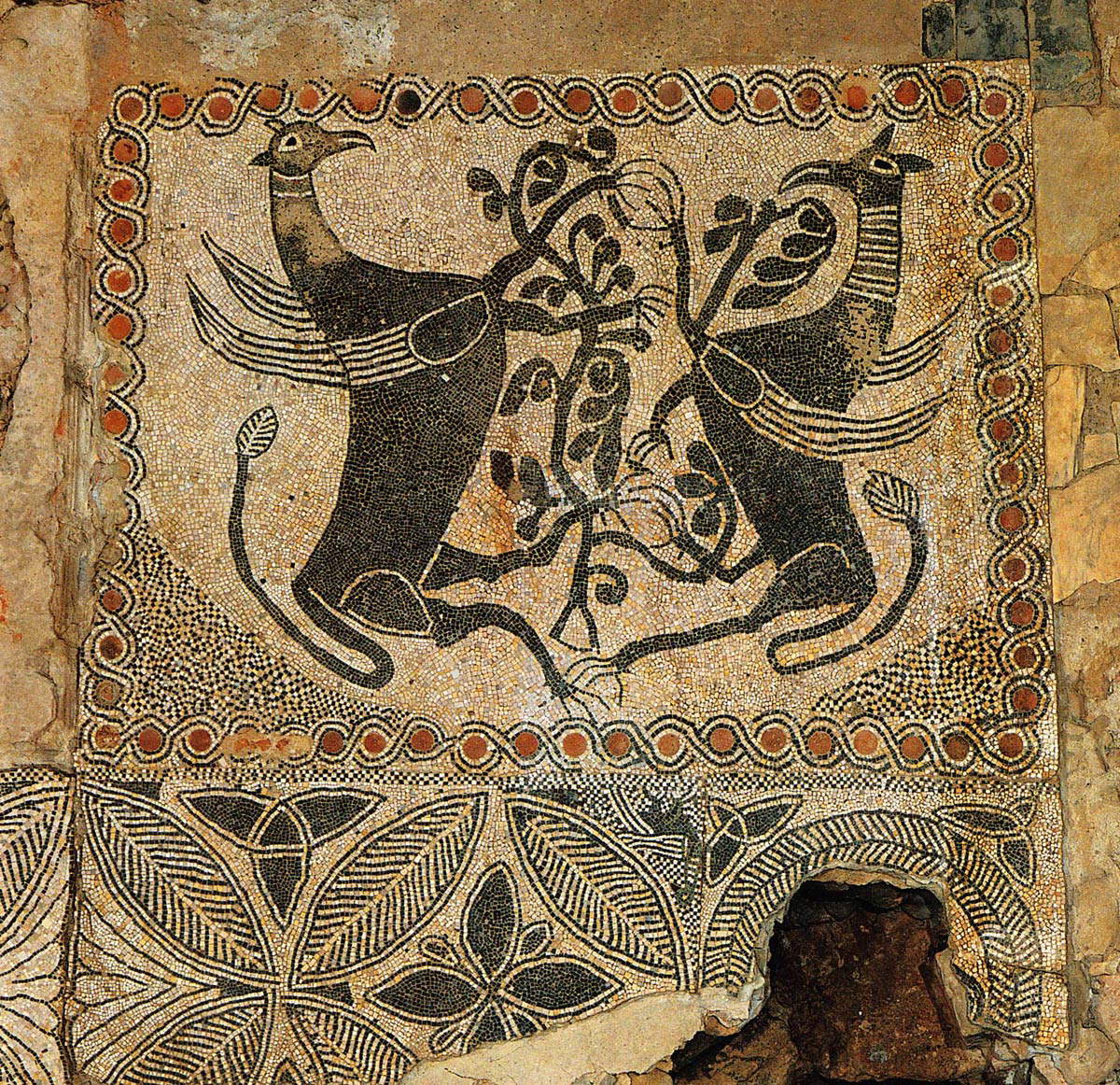
 |
| Animals and fantastic places in Italy's museums: Piedmont |
Warning: the translation into English of the original Italian article was created using automatic tools. We undertake to review all articles, but we do not guarantee the total absence of inaccuracies in the translation due to the program. You can find the original by clicking on the ITA button. If you find any mistake,please contact us.